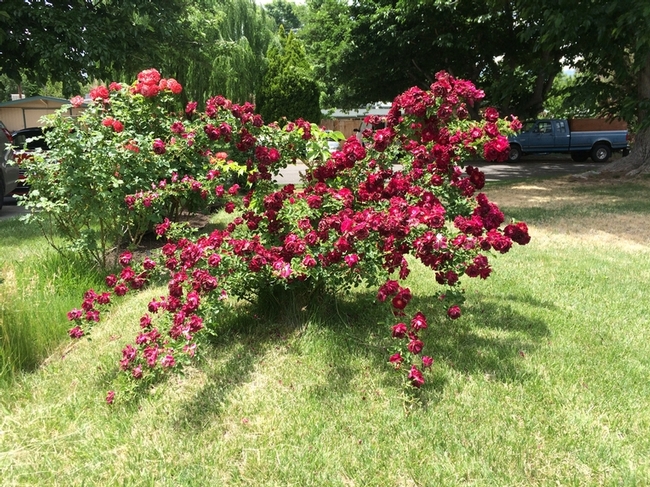May 30, 2018
It's rose season in the Owens Valley. Every yard in my neighborhood is full of blooms. Among all the cheery white, pink, yellow and red blossoms atop nice straight stems you can often find our most common cultivar of rose, 'Dr. Huey,' arching its long, weedy neck up and then back toward the ground with a heavy load of dark red blooms.
Although it was released in 1920, few gardeners deliberately plant 'Dr. Huey' roses. It's a vigorous rambler that only flowers once, usually in May for us. So how did it get here?
As you can see from the picture 'Dr. Huey' is a VERY VIGOROUS rose. (That is one year's growth!) For that reason it was—and still is—commonly used as a rootstock to graft other roses onto. That beautiful 'Veterans Honor' rose you bought is probably grafted onto it. Its strong vigor makes it a good choice to help rose scions grow well, but it does have a tendency to, well, escape.
It's not uncommon to find suckers emerging at the base of a rose bush. These suckers will usually be very glossy and the leaves will look a little different than the rest of the plant. That's 'Dr. Huey' trying to escape. Dr. Jekyll would have been a better name. When you see these suckers, do your best to prune them off. If they are left to grow, they will eventually take over as the dominant shoots of the plant and will starve out the desirable cultivar grafted onto it. This is how we have so many 'Dr. Huey' roses in our yards.
Of course, you may just decide to keep it. It does have a graceful arching form and a real will to live. It's a hard plant to kill—even on purpose! Since it only blooms once a year, it is best to prune it after it flowers. Don't be gentle with pruning it. Neglect will lead to a giant, thorny mess.
'Dr. Huey' is not very prone to problems, which is good and bad, I suppose. It doesn't have issues with aphids as severely as more desirable roses, but it still gets them. Usually control is not necessary. The most common malady is powdery mildew. Again, probably not worth worrying about since it is not fatal.
It may not be the best of all roses, but, to its credit, it is a rose anyone can grow. And you probably already have it!
